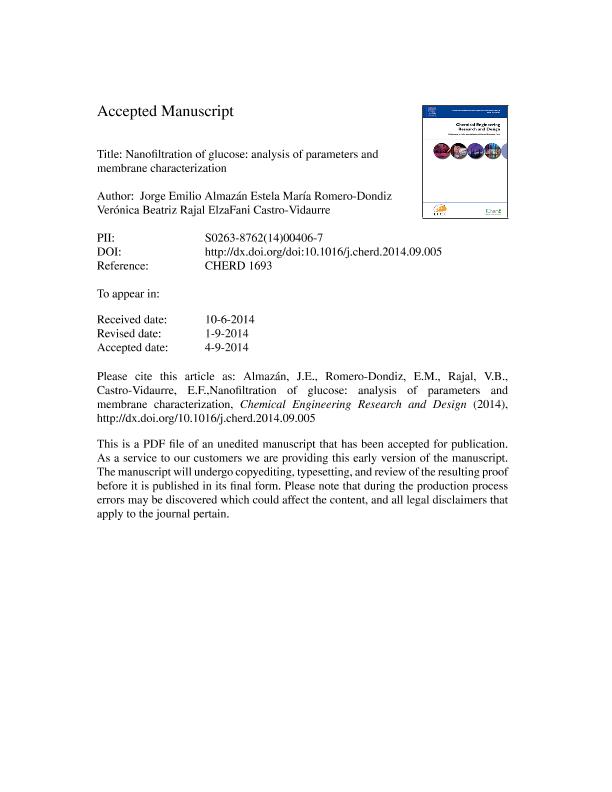Artículo
Nanofiltration of glucose: Analysis of parameters and membrane characterization
Almazán, Jorge Emilio ; Romero Dondiz, Estela María
; Romero Dondiz, Estela María ; Rajal, Verónica Beatriz
; Rajal, Verónica Beatriz ; Castro Vidaurre, Elza Fani
; Castro Vidaurre, Elza Fani
 ; Romero Dondiz, Estela María
; Romero Dondiz, Estela María ; Rajal, Verónica Beatriz
; Rajal, Verónica Beatriz ; Castro Vidaurre, Elza Fani
; Castro Vidaurre, Elza Fani
Fecha de publicación:
09/2014
Editorial:
Elsevier
Revista:
Chemical Engineering Research & Design
ISSN:
0263-8762
Idioma:
Inglés
Tipo de recurso:
Artículo publicado
Clasificación temática:
Resumen
Membrane characterization and modeling of nanofiltration processes of uncharged solutes are of special interest for the food industry. In this work two commercial membranes, DK and DL, were used to concentrate glucose solutions. Membranes were characterized according hydrophobicity, thickness, porosity, and hydraulic permeability. The influence of pressure and concentration of glucose on the permeate flux and rejection were studied. Both membranes presented a great potential for the food industry due to their high rejection of glucose. The osmotic pressure model was combined with film theory and the real driven force was calculated taking into account the osmotic pressure and the concentration polarization. Both phenomena influenced the process (concentration polarization only in the most dilute solutions at low pressure) and the permeability for glucose solutions was similar to the hydraulic permeability. A mathematical model based on the Donnan-Steric Pore Model was used to determine the pore radius and the effective thickness of both membranes. As the concentration inside the pore (needed for the calculations) is difficult to measure experimentally, various alternatives were proposed. The average of the concentration at the interface and permeate best fitted the experimental data. The model was applied successfully; the maximum error was 8% within the range of concentrations (5–100 g/L) for the DL membrane and 5% for the DK membrane up to 50 g/L.
Palabras clave:
Nanofiltration
,
Glucose
,
Osmotic Pressure Model
,
Concentration Polarization
Archivos asociados
Licencia
Identificadores
Colecciones
Articulos(INIQUI)
Articulos de INST.DE INVEST.PARA LA INDUSTRIA QUIMICA (I)
Articulos de INST.DE INVEST.PARA LA INDUSTRIA QUIMICA (I)
Citación
Almazán, Jorge Emilio; Romero Dondiz, Estela María; Rajal, Verónica Beatriz; Castro Vidaurre, Elza Fani; Nanofiltration of glucose: Analysis of parameters and membrane characterization; Elsevier; Chemical Engineering Research & Design; 94; 9-2014; 485-493
Compartir
Altmétricas



